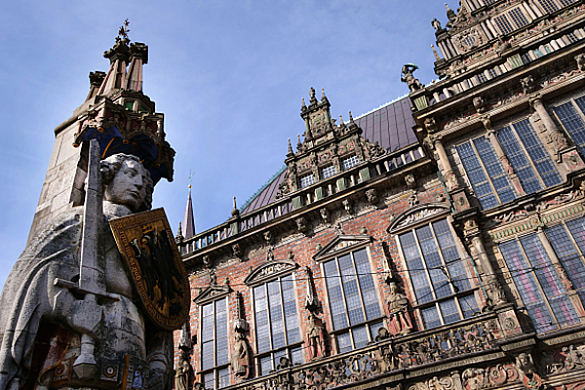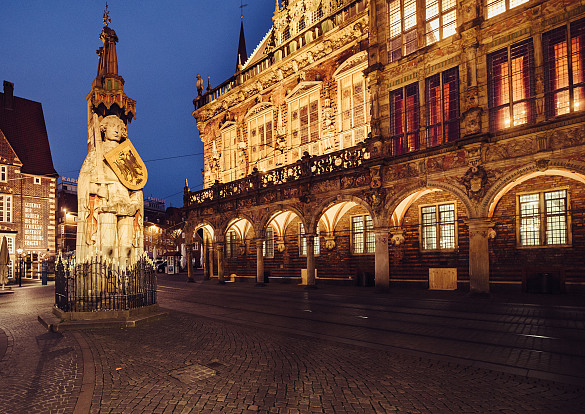
The Town Hall and the Roland on the market place in Bremen have been UNESCO World Heritage Sites since 2004. The ensemble is a "unique testimony" to the development of civic autonomy and market rights as they have evolved over the centuries in Europe.
The original function of the two subsequent floors has also been retained until today. The upper floor was reserved for representation, and the ground floor was intended for use by the "market people", today all citizens. Thus the population was joined with the authority - a function that has been retained until today and another reason to enlist the Town Hall on the World Heritage List.
UNESCO also sees the special importance of the Bremen Town Hall in its artistic and stylistic values: today its main façade represents the so-called Weser Renaissance and is considered a highly representative example of this style. The medieval attributes of this building - such as the emblematic sculptural decoration in sandstone - remained at their original position. It is also to be underlined that the Bremen Town Hall reflects European-wide trends at the end of the 16th and early 17th centuries.
The Bremen Town Hall was expressly built for the use of the City Council. The architecture and the sculptures do not only carry strong references to the imperial and Episcopal foundations of the city, but at the same time underline the policies of self-government, which had been chosen by the Council. The construction of the Town Hall demonstrated grown self-confidence of the city council and its civic claim to power.
The Bremen stone Roland, erected in 1404, is 5.5 metres tall and one of the oldest and most representative roland statues, which were once erected on marketplaces in Central Europe as a symbol of freedom and market rights. It is referred to a historical figure, paladin of Emperor Charlemagne. The Bremen Roland is to underline: the Emperor is the founder of the city, it was him who has given the city its rights and privileges. The Roland and the Town Hall of Bremen are part of humanity's world heritage as they bear a unique testimony to civic autonomy and sovereignty as these developed in Europe over the centuries. The symbolism of the Town Hall and the Roland reflects the autonomous status of the Bremen city state until today.

Bremen rightfully claims to be one of the oldest city republics of the world. This is because Bremen has been a trading place ever since it was founded around the year 800. In order to be successful, merchants and traders have to be open-minded and tolerant. As Bremen, during the Middle Ages, developed into one of the most important and wealthy commercial towns in northern Europe, being a member of the Hanseatic League, tolerance and open-mindedness towards the unknown, in other words a cosmopolitan outlook, became a characteristic feature of this town and its citizens. Also, due to the ongoing economic success and resiliency of its merchant citizens, there developed a form of government which never knew the rule of an aristocracy but was founded on merits and achievements of its leading citizens: The citizens of Bremen handled their affairs by themselves and among their peers. This is also why Bremen drew on the tradition of the ancient Roman city republic as it developed its own early forms of a constitutional government. – That this orientation still was valid and observed in the early 20th century is witnessed by the inscription over the entrance of New Town Hall: "SPQB”, meaning "Senatus Populusque Bremensis” in adaption of the traditional inscription of ancient Rome: "SPQR, Senatus Populusque Romanus”. Sustained economic success over centuries, a tradition of self-sufficiency in handling their affairs by themselves combined with a political tradition drawing on the achievements of the Roman Republic formed what came to be labelled as a certain "civic self-confidence" of the citizens of Bremen. It influences their outlook and identity to this day.